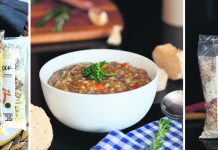Fluid art, liquid art, acrylic pouring… whatever you call it, there’s nothing more satisfying than creating abstract masterpieces by letting colour run wild. Vanessa Mayhew takes us through the process to creating show-stopping art.
From the peaceful corners of her Hillcrest studio, Vanessa Mayhew uses acrylics with a runny consistency to create psychedelic works of art that are as much about the creative process as they are about the finished product.

Watching her pour colour onto canvas is an experience that can be described in a similar nature to that of metamorphosis. As the colours blend and warp, you find yourself less concerned with perfection and more excited about the unknown, because the end result is never quite what you’d imagined.
A Jill of all crafts and mistress of none (as she dubs herself), perfectly sums up Vanessa’s attitude to everything creative. With her red hair and deep green eyes, she radiates joy as she puts on her artist’s smock and begins to pick out the colours she fancies for her next work of ‘fluid art’ as she calls it.
Who doesn’t love an excuse to make a beautiful mess?
“As an artist always learning to expand on my skills, I opened my studio (VM Arts) at Meadow Garden off Inanda Road to teach mosaicking and pewter. Art is often an expression of the emotions you feel in life that guide and teach you the greatest lessons about love, fear, heartbreak and happiness. It was a time of self-discovery for me too. I had gone through some hard times, was stuck in a job I hated and was questioning who I really was. But in spite of the heavy weight on my shoulders, there was a nagging feeling that I had a bigger purpose. That’s when I discovered fluid art.”
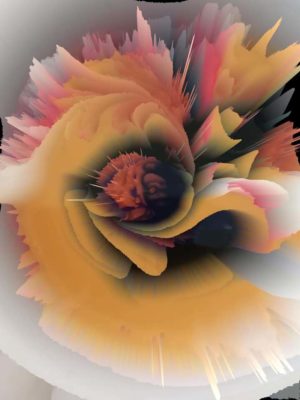
Through fluid art, Vanessa says she learned to explore the beauty of her own feelings and at the same time she began to play with the mess that it created. She thrived on it so much that she decided to host art lessons in fluid art and now teaches others this exciting art technique three times a week, sharing with them how to mix paints and get them all at an even consistency so that nature and fluid dynamics can do the rest.
“Fluid art is huge overseas and it’s slowly becoming more recognised here. I’m excited to share that I was recently invited to exhibit in an art gallery in London – something that has really elevated my passion for this medium of art. What’s so great about fluid art is that it opens itself to anyone, whether you have an artistic background or not. It’s very immediate and you cannot anticipate what comes out, but it is generic and abstract – more about colour and an image that can be looked at by different people and perceived in many different ways. Anybody is able to create with this technique; women, children and men (yes, I do have men in my classes and they love it!) It’s pure escapism – an opportunity to leave the outside world at the door and immerse yourself in creativity.”
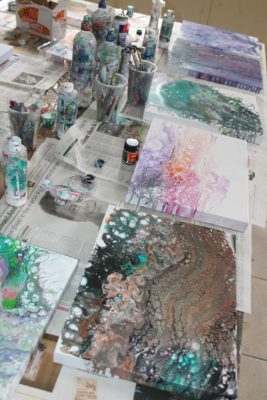
The key to a good acrylic pour is consistency… of paint that is. You’ll want to use fluid acrylics, which have a much thinner consistency than heavy bodied acrylics. If you only have thicker acrylics on hand, you can still use them, but you’ll want to thin them out with water.
While fluid acrylics have a high viscosity, you will still want to add something to create the consistency you are after. What you add depends on whether you are doing a coated pour, where the finished product has bold, even layers of colour, or a wash pour, where the finished product almost looks like layers of watercolour. To get the viscosity and pouring rate you’d like, you can first adjust with water.
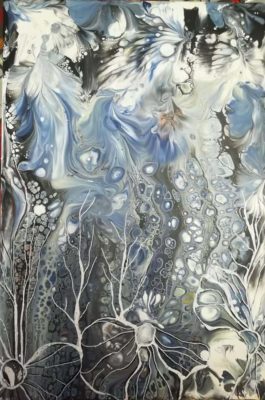
“Beyond water, a good pouring medium is key. Alcohol is a popular additive used to create interesting circular cells, which occur when the fast-drying alcohol tries to escape. Glue, silicon and certain other oils can also be used. All can yield interesting results but may diminish the longevity of your painting as they can change the properties of the paint.”
Vanessa stresses that experimentation is key, but two basic techniques for pouring paint will get you started on a journey to creating your own masterpiece – straight or dirty pouring.
“With the dirty pour technique which I use most often in my classes, all your paints are placed into one cup prior to being poured across the canvas. Consistency is key here – if the paints are too runny they will blend together in the cup and come out muddy, but once you get a feel for the densities you can create with different colours, you’ll see that anything is possible.”
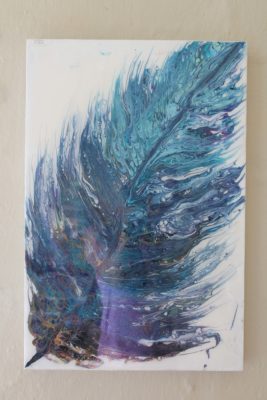
It’s intense, loads of fun and judging by the sheer number of vibrant canvasses busy drying in her studio, many bright-eyed beginner artists eager to try their hand at fluid art have already walked through her door. Better yet is that most, if not all, have found great satisfaction in creating something that doesn’t look wrong, simply because there are no hard and fast rules.
When you understand the science of fluid art, you suddenly have a lot more control over work that was once seemingly only accidental.
“You can easily Google the materials and weights of certain pigments within paints and then pick colours to mix and swipe, but here is always a bit of mystery as to what your final piece will look like, and that is part of the joy of this technique.”
Once dried, each piece can be left as is or finished off with resin. This, Vanessa says, is a personal choice, depending on whether the created piece lends itself to it, as well as the overall look and feel you would like to achieve in the space where you might hang it.

“Creating art can be so personal, but the feedback I’ve had surrounding fluid art has been incredibly positive. It has made me realise there is a need for this kind of art. I found a medium through which to express myself in a way I was never able to before, and I hope, through this medium, to be able to reach out to others and offer them a different experience, a new way of tapping into mixed emotions and let it all go. In an ideal world, as well as teaching others how to master the art of fluid art, I would like to work my way into the world of interior décor, and see a time ahead where my own art is recognised and desired by home décor enthusiasts. Fluid art opens up so many possibilities and is definitely worth exploring and adding to any artist’s tool belt. There’s something so deeply satisfying about combining colours and watching them spill across a surface towards endless possibility.”
You can follow Vanessa on Facebook: VM Arts or Instagram @vanessamayhewcreative or contact her on 084 407 5570.




